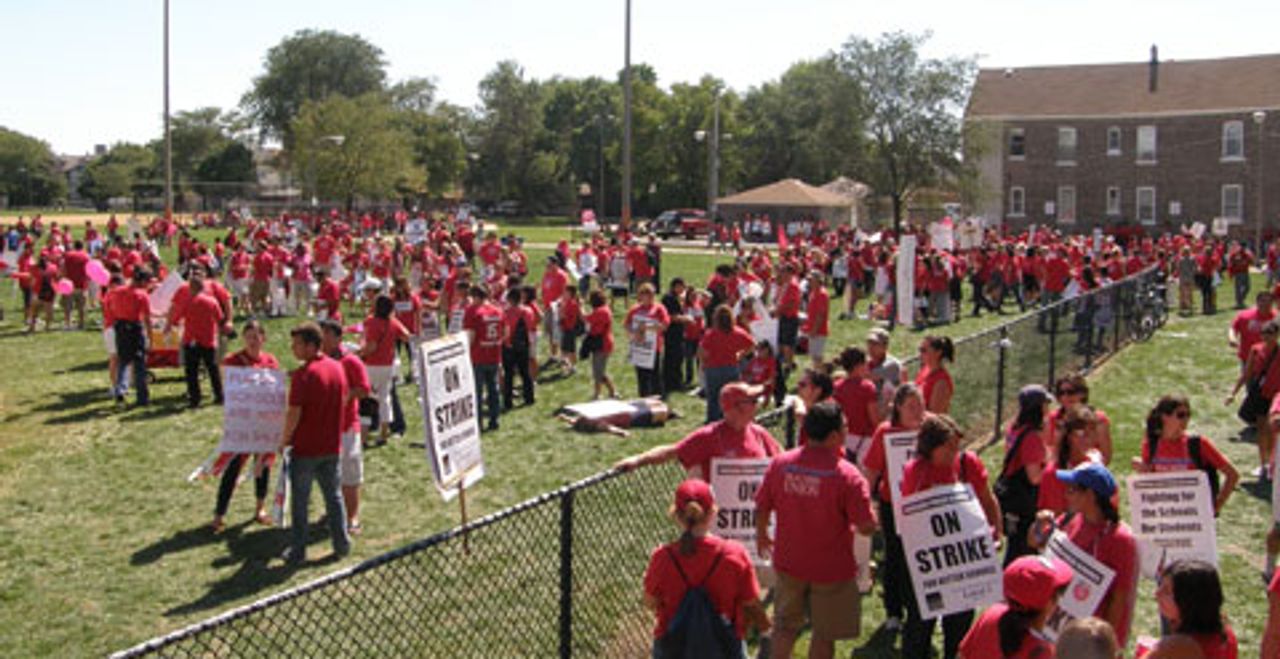 Teachers marching through Chicago
Teachers marching through ChicagoSocialist Equality Party vice presidential candidate Phyllis Scherrer joined Chicago teachers for the third day of their strike on Wednesday. She campaigned at Kelly High School, the location of one of the three rallies held by the striking teachers throughout the city. During the rally, Scherrer and her campaign team passed out hundreds of leaflets and spoke with several teachers about the political issues involved with their struggle.
“This is a fight for the basic social rights not just of teachers, but of workers throughout Chicago, the United States and internationally,” Scherrer said to a group of teachers. “The Socialist Equality Party rejects the claim by [Chicago Mayor] Rahm Emanuel and the two big business parties the Democrats and Republicans, that there is no money for education. There is plenty of money, but it is stolen from the working people and given to the banks.”
She continued, “This struggle is the opening salvo against the living standards and social rights of the entire working class. They will not stop at education. The teachers strike must be made into a general struggle against all austerity measures.”
 The rally at Kelly HS
The rally at Kelly HSThe Chicago Teachers Union is in ongoing discussion with Emanuel on a new contract. CTU President Karen Lewis has made clear that the union has already made significant concessions (See, “Mayor Emanuel plans to close one-fifth of Chicago public schools”)
Many teachers spoke about the conditions imposed on them by Chicago Public Schools (CPS), and the hypocrisy of Emanuel's claim that it is the strike—rather than CPS and the attack on public education being carried out by the city—that is hurting children.
“The conditions for students are horrible. In general, there is one counselor for every one thousand students in the schools,” said Allison, an elementary school counselor. “When they close down community agencies like free clinics and mental health agencies, the students are referred to the schools. I have to decide to refer the student to an agency where they have to pay for services or keep them and provide services for them myself. This is a difficult decision since the ratio between counselors and students is already so high.
“In the state of Illinois, it is over 900 students to one counselor. The American School Counselors Association says that there should be a ratio of 1 counselor for every 250 students. We have four times that in Illinois!
“We are not just counselors anymore either. We administer testing, provide care for students, provide lessons in classrooms to help support teachers, run counseling groups, have individual sessions for students, and follow the cases of students with IEP’s and 504’s [Individual Education Plans for students with moderate to severe emotional, learning and physical disabilities]. I currently have 54 students with IEP’s and 504’s. The school year has just started.
“When I am unable to provide services to a student due to my caseload, then it falls on the classroom teacher. When they are unable to resolve these issues, they are blamed—despite their heroic efforts—for being bad teachers because the students do not do well on a test! That’s when they fire teachers and close a school, creating unimaginable stress on communities that are already in a fragile state.”
Claudia, a 7th and 8th grade teacher, spoke about the conditions in the schools. “I was scheduled to work in a second floor room, but the air conditioner kept breaking and it was difficult to get it fixed. Now I am in the hot and muggy basement. They said that if you did not have an air conditioner before 2008, then you cannot get one now. They only have five in the whole school. Some work and some don’t.
“On the second floor I taught kids with no shades and the sun in their eyes and no air conditioning. Try teaching 27 middle school students science under those conditions.”
Scherrer also spoke with Carmen Guzman, who came to the rally with a sign stating that she had 39 students in her kindergarten class. She explained, “I enjoy my job, but right now I have to be creative with 39 kids in my classroom. I have an aide whenever it’s possible. That means one hour out of four, one day a week to five days a week. Whenever they have time to come to my room.
“CPS says that we cannot negotiate for smaller classrooms. Chicago is the only city that won’t allow class size to be part of negotiations.”
Some teachers expressed frustration with the CTU. “We aren't being told anything,” said one teacher. “There is nothing public about the bargaining meetings. The only thing we know about is where to picket and where to rally. I want to know the details of the contract that is being worked out, but the CTU gives us nothing.”
“None of the strike fund goes directly to us,” another teacher added. “It goes to t-shirts, banners, advertisements, etc, but there is no strike pay given out at all.”
On a picket line Tuesday, teachers spoke with Scherrer about the push for charter schools in Illinois and the drive by Emanuel to privatize public education.
“The Illinois charter movement started in 1997,” said Neerja, a high school science teacher. “Then, in 2004, the Renaissance 2010 program was made public. The city of Chicago announced they were going to open a hundred charter schools by 2010. The worst part of all this is that the charter schools aren’t better, even when they cherry pick students to buff scores. All they do is take money from public education and give it to the corporations running charters.”
